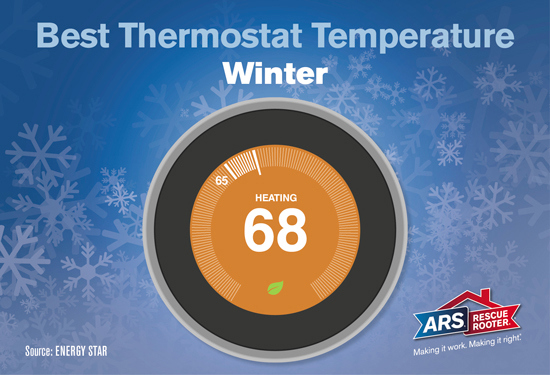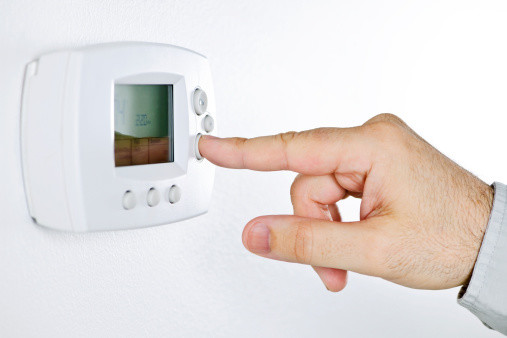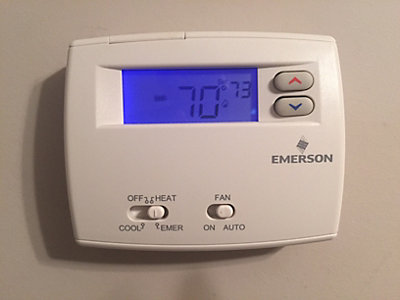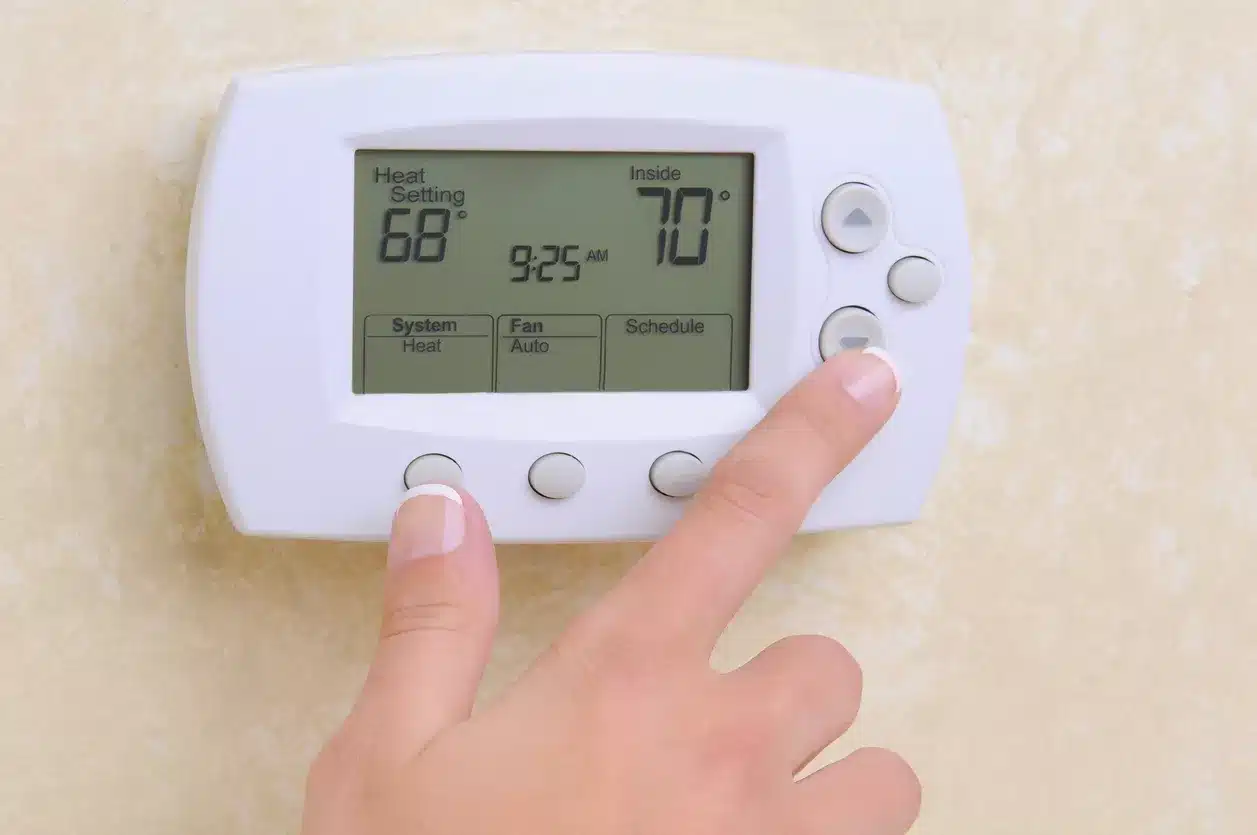Check Best Thermostat Pricing in Amazon
** As an Amazon Associate, I earn from qualifying purchases.
Setting the thermostat in winter can be tricky. What’s the ideal temperature for comfort and energy savings?
During the colder months, finding the right thermostat setting is crucial. It ensures your home stays cozy while keeping energy bills in check. Many factors influence the perfect temperature, such as your home insulation, personal comfort, and even the time of day.
Understanding these can help you set the thermostat to a level that balances warmth and efficiency. In this guide, we’ll explore the best practices for setting your thermostat in winter. This will keep your home warm and your energy costs low. Let’s dive in and find that sweet spot for your winter thermostat settings.

Credit: www.ars.com
Finding The Right Temperature
Finding the right temperature for your home in winter can be tricky. You want to stay warm without breaking the bank. It’s important to balance comfort, efficiency, health, and safety.
Balancing Comfort And Efficiency
Set your thermostat to 68°F during the day. This temperature keeps you warm while saving energy. Lower it by 10-15 degrees when sleeping or away. This can cut your heating bill significantly.
Use blankets, warm clothing, and space heaters in occupied rooms. This way you stay cozy without raising the thermostat. Sealing windows and doors also helps retain heat.
Considering Health And Safety
Don’t set the temperature too low. Cold indoor air can cause health issues. Elderly people and young children are more vulnerable. Keep their rooms at a comfortable temperature.
Ensure your heating system is in good condition. A well-maintained system works efficiently and safely. Use a carbon monoxide detector. It alerts you if there’s a problem with your heating system.
Daytime Settings
When the winter chill sets in, knowing how to set your thermostat during the day can make all the difference in comfort and energy savings. Your choices can impact your mood, productivity, and utility bills. Let’s dive into the best daytime settings for your thermostat.
Optimal Daytime Temperature
Finding the perfect daytime temperature can be a balancing act. Experts suggest setting your thermostat around 68°F (20°C) during the day while you’re at home. This temperature strikes a good balance between comfort and efficiency.
Think about it: a slightly cooler home means your heating system works less, saving you money. Plus, wearing a cozy sweater or using a blanket can make 68°F feel just right. Have you tried experimenting with this setting yet?
Adjusting For Activities
Your daily activities should influence your thermostat setting. If you’re cooking, the oven and stove will naturally warm your home, allowing you to lower the thermostat a bit. This can keep your kitchen from getting too hot and stuffy.
On the other hand, if you’re working from home and sitting still, you might prefer a slightly warmer setting. Adjust the thermostat up a degree or two for a comfortable work environment. What activities do you do that affect your home’s temperature?
Also, consider using a programmable thermostat. It can automatically adjust the temperature based on your schedule, ensuring comfort when you need it and savings when you don’t. Have you noticed how a small tweak in your routine can lead to significant savings?
Setting your thermostat thoughtfully during the day can lead to a more comfortable and cost-effective winter. What changes will you make to your daytime settings?
Nighttime Settings
Finding the perfect thermostat setting at night during winter can be a bit challenging. You want to stay warm without feeling stuffy or overheating. Let’s explore some ideal nighttime settings to keep you comfortable and cozy.
Best Sleep Temperature
Experts suggest that the best temperature for sleep is between 60 and 67 degrees Fahrenheit. This range allows your body to cool down and prepare for a restful night. A cooler room can help you fall asleep faster and stay asleep longer.
Try setting your thermostat to around 65 degrees before you go to bed. If you find this too cold, adjust it by a degree or two. Everyone’s comfort level is different, so find what works best for you.
Consider using a programmable thermostat. Set it to lower the temperature automatically at night, so you don’t have to remember to do it manually. This also helps save on energy costs.
Using Additional Bedding
Adding extra bedding can make a significant difference in your nighttime comfort. A thicker comforter or an extra blanket can keep you warm without having to crank up the thermostat.
Layering your bedding allows you to adjust as needed. If you get too warm during the night, you can easily remove a layer. On colder nights, adding an extra blanket can provide that extra warmth you need.
Consider using flannel sheets during winter. They are warmer than regular cotton sheets and can help you stay cozy. Alternatively, an electric blanket can provide adjustable warmth throughout the night.
What strategies do you use to stay comfortable at night during winter? Share your tips in the comments!
Thermostat Technology
Thermostat technology has advanced significantly in recent years. Modern thermostats offer more than just temperature control. They provide convenience, energy savings, and comfort. Understanding these technologies can help you make the best choice for your home.
Programmable Thermostats
Programmable thermostats allow you to set schedules for heating. You can program different temperatures for different times of the day. This ensures your home stays comfortable while saving energy. For example, lower the temperature when everyone is at work. Raise it just before you come home.
This type of thermostat is user-friendly and efficient. It helps in reducing energy bills. It also reduces the effort needed to adjust settings manually. You can find models with different programming options. Some even offer up to seven-day scheduling. This means you can have a unique program for each day of the week.
Smart Thermostat Features
Smart thermostats take convenience to the next level. They connect to your home Wi-Fi. This allows you to control them from your smartphone. You can adjust the temperature from anywhere. Some models learn your schedule over time. They automatically adjust settings based on your habits.
Check Best Thermostat Pricing in Amazon
** As an Amazon Associate, I earn from qualifying purchases.
These thermostats often come with energy-saving features. They provide usage reports to help you understand your energy consumption. Some even integrate with other smart home devices. This includes voice-controlled assistants like Alexa or Google Assistant.
Smart thermostats offer a blend of convenience and efficiency. They make managing your home’s temperature easy and intuitive. Investing in one can lead to significant energy savings.
Energy-saving Tips
Winter can be a challenging season, especially for those looking to save on energy bills. Setting the thermostat correctly can make a big difference. But there are other ways to save energy too. Here are some useful tips to help you stay warm and save money.
Reducing Energy Bills
Lowering the thermostat even by a few degrees can reduce your energy bill. Setting it to 68 degrees Fahrenheit during the day is a good start. At night, lower it to 60 degrees. Use extra blankets to stay warm. This small change can make a big difference.
Weatherproofing Your Home
Weatherproofing your home ensures heat stays inside. Check for drafts around windows and doors. Use weather stripping to seal gaps. Thick curtains can also help keep the cold out. This simple step can save you a lot on heating costs.
Don’t forget to insulate your attic and walls. Proper insulation keeps the heat in. It also reduces the workload on your heating system. This leads to lower energy bills and a warmer home.

Credit: www.tlcplumbing.com
Zoned Heating
During winter, finding the perfect thermostat setting can be tricky, especially if different areas of your home have different heating needs. Zoned heating offers a brilliant solution by allowing you to control the temperature in specific areas or “zones” independently. This means you can keep your living room toasty while saving energy in rarely-used rooms.
Benefits Of Zoned Systems
One of the major benefits of zoned heating is improved comfort. Imagine sitting in your cozy living room, knowing your unused guest room isn’t being unnecessarily heated. This ensures everyone in your household enjoys their preferred temperature.
Zoned systems also help save energy and reduce heating costs. By only heating occupied spaces, you avoid wasting energy on empty rooms. This can lead to noticeable savings on your utility bills.
Another advantage is the extended lifespan of your heating system. Since the system doesn’t have to work as hard to heat the entire house, it experiences less wear and tear. This means fewer repairs and a longer-lasting system.
Implementing Zoning
Implementing zoning in your home can be straightforward with the right approach. Start by identifying the different zones in your house. Common zones include the living room, bedrooms, and seldom-used areas like the basement or guest room.
Install programmable thermostats in each zone. These thermostats allow you to set different temperatures for various times of the day. For instance, you can set the bedroom to be warmer at night and cooler during the day when it’s unoccupied.
If you’re unsure about handling this yourself, consider consulting a professional. They can assess your home and recommend the best zoning solution. This ensures that your system is set up efficiently and effectively.
Have you ever noticed how some rooms in your house are warmer than others? Zoned heating could be the answer. Not only does it enhance comfort, but it also brings significant energy savings. Isn’t it time you gave zoned heating a try?
Dealing With Temperature Fluctuations
Dealing with temperature fluctuations during winter can be tricky. The weather outside can change quickly, and your indoor temperature needs to stay comfortable. Here are some tips to help you manage these changes and keep your home cozy.
Handling Cold Snaps
Cold snaps can make your home feel freezing. To handle this, set your thermostat a few degrees higher. This helps maintain warmth even when the outside temperature drops suddenly. Consider using a programmable thermostat for automatic adjustments. It can save energy and keep your home comfortable during unexpected cold periods.
Maintaining Consistent Comfort
Keeping a steady indoor temperature is important for comfort. Set your thermostat to a consistent temperature, around 68°F, during the day. Lower it by a few degrees at night to save energy while you sleep. Use insulated curtains and draft stoppers to keep the warmth in and the cold out. This helps maintain a comfortable environment without constantly adjusting the thermostat.

Credit: plumblineservices.com
Alternative Heating Solutions
Set your thermostat to 68 degrees Fahrenheit during the winter. Lower it at night or when away to save energy.
Finding alternative heating solutions for your home during winter can save you money and make your living space more comfortable. If you’re looking to reduce your energy bills and still stay warm, consider some of these options. Each of these methods can be tailored to your specific needs and preferences, offering flexibility and efficiency.Space Heaters
Space heaters are a popular choice for many households. They allow you to heat specific rooms without wasting energy on the entire house. This can be especially useful if you spend most of your time in a single area. There are various types of space heaters, including electric, gas, and oil-filled models. Electric space heaters are easy to use—simply plug them in and adjust the settings. Gas heaters can be more efficient but require proper ventilation. Oil-filled heaters are slow to warm up but retain heat longer, making them ideal for prolonged use. One winter, I used an oil-filled space heater in my home office. It kept the room warm without significantly impacting my electricity bill. Have you tried using a space heater to focus warmth where you need it most?Radiant Floor Heating
Radiant floor heating is a luxurious yet practical solution. It involves installing heating elements beneath your floors, providing even warmth throughout the room. This method eliminates cold spots and can be more energy-efficient than traditional heating systems. There are two main types of radiant floor heating: electric and hydronic. Electric systems use electric cables or mats, while hydronic systems use heated water circulated through tubes. Hydronic systems are often more cost-effective for larger areas or entire homes. Imagine waking up on a cold winter morning and stepping onto a warm floor. This can be your reality with radiant floor heating. Wouldn’t it be nice to eliminate the shock of cold tiles on your feet? Exploring these alternative heating solutions can lead to a more comfortable and energy-efficient home. Have you considered any of these options for your winter heating needs?Frequently Asked Questions
Is 72 A Good Temperature For Winter?
Yes, 72°F is a comfortable temperature for winter. It balances warmth and energy efficiency, ensuring a cozy home.
What Is The Best Setting For Your Thermostat In The Winter?
Set your thermostat to 68°F during winter days for energy efficiency. Lower it at night or when away.
What Should I Set My Thermostat To During A Freeze?
Set your thermostat to 65-70 degrees Fahrenheit during a freeze. This helps prevent pipes from freezing and bursting.
Is 74 Degrees Cold In A House?
74 degrees is generally comfortable for most people indoors. It may feel cool to some, but not cold.
Conclusion
Finding the right thermostat setting in winter is crucial. It ensures comfort and saves energy. Experiment with settings between 68°F and 72°F. Adjust for your personal needs. Lower temperatures at night can help save more. Use blankets for extra warmth.
Smart thermostats can optimize settings. Maintaining your HVAC system is essential. Regular checks prevent issues. Following these tips can lead to a cozy, efficient home. Stay warm and enjoy the season!
Check Best Thermostat Pricing in Amazon
** As an Amazon Associate, I earn from qualifying purchases.


